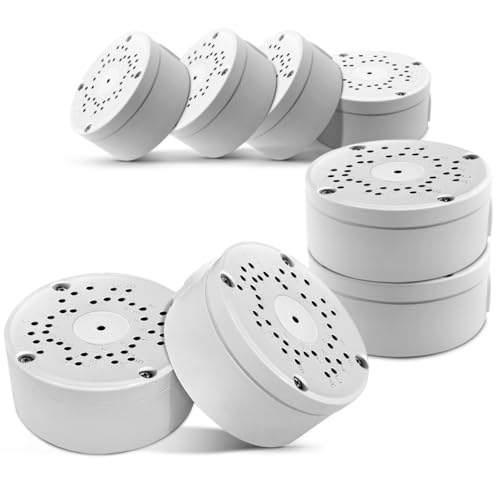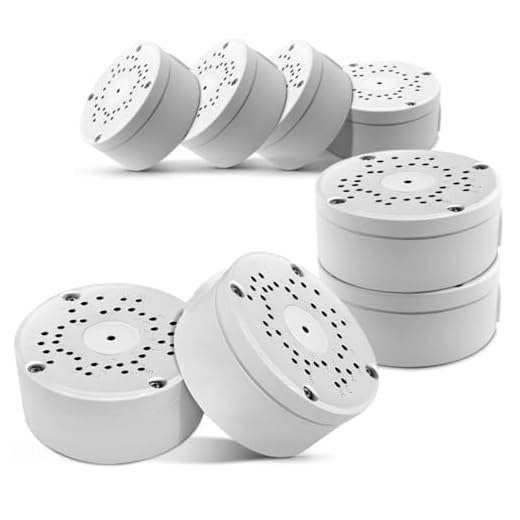




Security cameras are an essential part of any surveillance system, providing a crucial layer of protection for homes and businesses. However, one of the key factors to consider when installing security cameras is the height at which they should be mounted.
Mounting security cameras at the right height is important to ensure optimal coverage and effectiveness. If cameras are mounted too low, they may be vulnerable to tampering or vandalism. On the other hand, if cameras are mounted too high, they may not capture clear images of individuals or vehicles passing by.
So, how high should you mount security cameras? The ideal height for mounting security cameras is typically between 8 to 10 feet above the ground. This height provides a good balance between capturing clear footage and minimizing the risk of tampering. It also allows cameras to have a wide field of view while still being within reach for maintenance and adjustments.
Optimal height for security cameras
When installing security cameras, it’s crucial to consider the optimal mounting height to ensure effective surveillance. The height at which you should place your security cameras depends on the area you want to monitor and the type of camera you are using.
For general surveillance purposes, a recommended height for mounting security cameras is between 8 to 10 feet above the ground. This height provides a good balance between capturing clear footage and staying out of reach from potential tampering or vandalism.
However, if you are looking to monitor specific areas or objects, such as doorways or windows, it’s advisable to place the camera at eye level or slightly above to capture facial features or other crucial details.
Keep in mind that the optimal height may vary depending on the specific circumstances of your property and the angle of view required. It’s essential to test different heights and angles to find the best placement for your security cameras.
Factors to consider when mounting cameras
When mounting security cameras, there are several factors to consider to ensure optimal performance and coverage. Here are some key factors to keep in mind:
Location
Choose strategic locations for your cameras that provide the best view of the areas you want to monitor. Consider factors such as line of sight, lighting conditions, and potential obstructions.
Height
The height at which you mount your cameras can greatly impact their effectiveness. Mount cameras at a height that provides a clear view of the area while also keeping them out of reach of potential tampering.
| Factors | Considerations |
|---|---|
| Field of view | Ensure the camera’s field of view covers the desired area without any blind spots. |
| Accessibility | Mount cameras in locations that are easily accessible for maintenance and adjustments. |
| Weather resistance | Choose cameras that are weatherproof and can withstand outdoor conditions if needed. |
| Legal considerations | Be aware of any legal restrictions or privacy laws that may affect camera placement. |
Importance of Camera Placement
Proper camera placement is crucial for maximizing the effectiveness of your security system. Placing cameras at the right height and angle can greatly enhance their ability to capture clear images and footage. Here are some key reasons why camera placement is important:
1. Coverage
Strategic placement of security cameras ensures maximum coverage of the area you want to monitor. By positioning cameras at the right height and angle, you can eliminate blind spots and capture a wider field of view.
2. Deterrence
Visible security cameras act as a deterrent to potential intruders or criminals. Placing cameras at eye level or in prominent locations sends a clear message that the area is being monitored, which can help prevent criminal activity.
| 3. Evidence | Well-placed cameras provide valuable evidence in case of incidents such as theft, vandalism, or trespassing. By capturing clear and detailed images, security cameras can help law enforcement identify suspects and solve crimes. |
Best Practices for Camera Positioning
When positioning security cameras, it is crucial to follow best practices to ensure optimal coverage and effectiveness. Here are some key guidelines to consider:
1. Height Matters
Mount your cameras at a height of around 9-10 feet for optimal coverage. This height provides a good balance between capturing clear images and keeping the camera out of reach of potential vandals.
2. Angle of View
Position your cameras at an angle that covers the areas you want to monitor without any obstructions. Avoid pointing cameras directly into bright light sources to prevent washout and ensure clear footage.
By following these best practices for camera positioning, you can maximize the effectiveness of your security system and enhance the overall security of your property.
Recommended Height for Outdoor Cameras
When installing outdoor security cameras, it is important to consider the optimal mounting height to ensure maximum effectiveness. The recommended height for outdoor cameras is between 8 to 10 feet above the ground. This height provides a good balance between capturing clear footage and keeping the camera out of reach of potential vandals.
Mounting the cameras too high can lead to a loss of detail in the footage, while mounting them too low can make it easier for intruders to tamper with or disable the cameras. By installing outdoor cameras at the recommended height, you can enhance the security of your property and ensure that your surveillance system is operating at its best.
Ideal Placement for Indoor Cameras
When it comes to mounting indoor security cameras, there are a few key factors to consider to ensure optimal coverage and effectiveness. Here are some guidelines for the ideal placement of indoor cameras:
| Height: | Mount the camera at a height of 7-9 feet above the ground for the best angle and coverage of the room. |
| Angle: | Position the camera so it has a clear view of the entire room, including entry points and high-traffic areas. |
| Obstructions: | Avoid placing the camera near obstructions like plants, curtains, or furniture that could block the view. |
| Privacy: | Be mindful of privacy concerns and avoid pointing the camera at areas where people may expect privacy, such as bedrooms or bathrooms. |
| Power source: | Ensure the camera is positioned near a power source for easy installation and maintenance. |
Impact of Camera Height on Surveillance Quality
When it comes to mounting security cameras, the height at which they are installed plays a crucial role in determining the overall surveillance quality. The ideal camera height can vary depending on the specific area being monitored and the purpose of the surveillance.
Advantages of Mounting Cameras at Different Heights
Mounting cameras at different heights can provide various advantages. Here are a few examples:
| Camera Height | Advantages |
|---|---|
| Low Height | Provides a closer view of individuals’ faces and activities. |
| Eye Level | Offers a balanced perspective and clear identification of individuals. |
| High Height | Provides a wider view of the area and enhances overall surveillance coverage. |
Choosing the Right Camera Height
When determining the optimal height for mounting security cameras, it is essential to consider factors such as the area of coverage, lighting conditions, and the specific objectives of surveillance. By strategically placing cameras at different heights, you can enhance the effectiveness of your surveillance system and improve monitoring capabilities.
Common mistakes in camera mounting height
When it comes to mounting security cameras, the height at which they are installed plays a crucial role in their effectiveness. Here are some common mistakes to avoid:
1. Mounting cameras too high: Placing cameras too high can result in a limited field of view, making it difficult to capture important details such as faces or license plates.
2. Mounting cameras too low: On the other hand, mounting cameras too low can make them vulnerable to vandalism or tampering. It can also lead to a distorted perspective, making identification of individuals challenging.
3. Ignoring the optimal viewing angle: It’s essential to consider the optimal viewing angle when mounting cameras. Positioning them at the correct height and angle can ensure maximum coverage and clarity of images.
4. Failing to adjust for specific locations: Different locations may require cameras to be mounted at varying heights depending on the purpose and environment. Failing to adjust the mounting height accordingly can compromise the effectiveness of the surveillance system.
By avoiding these common mistakes and carefully considering the ideal mounting height for each camera, you can enhance the security and surveillance capabilities of your system.
Tips for Adjusting Camera Height
When installing security cameras, the height at which you mount them plays a crucial role in their effectiveness. Here are some tips for adjusting camera height:
- Choose a height that provides a clear view of the area you want to monitor.
- Mount the camera at least 9 feet above the ground to prevent tampering.
- Aim the camera slightly downward for better facial recognition.
- Avoid mounting the camera too high, as it may reduce the quality of the footage.
- Consider the angle of view and adjust the height accordingly to cover the desired area.






